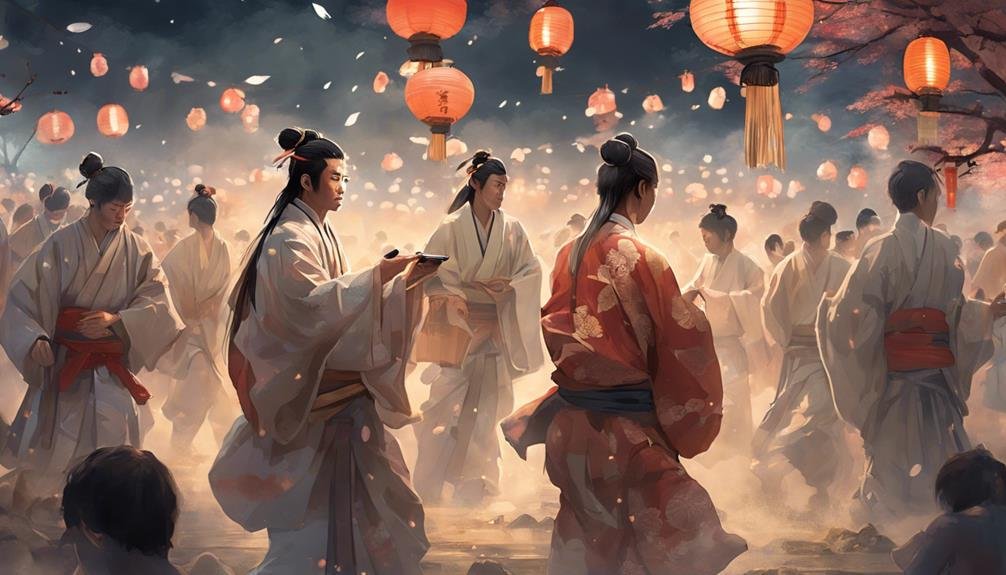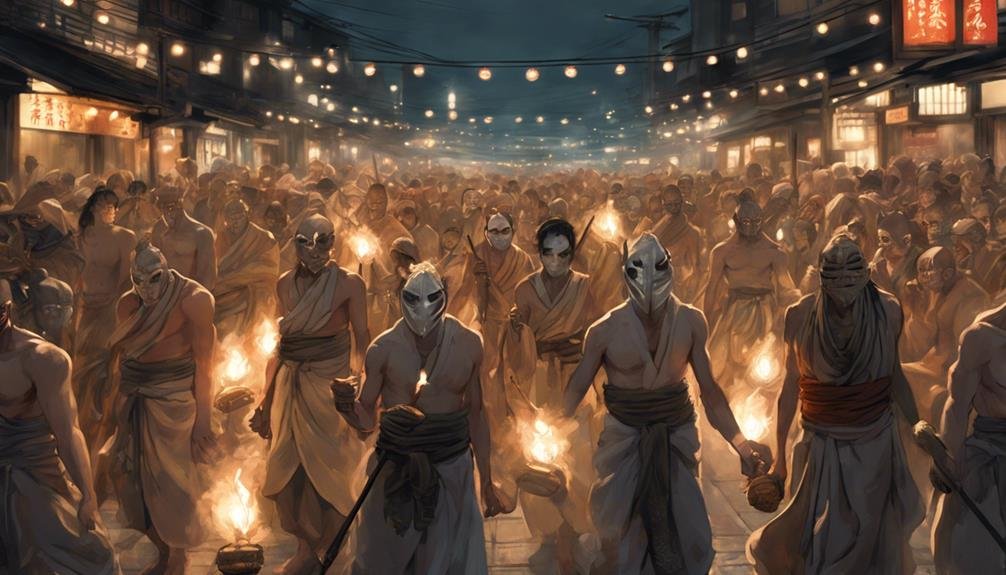Explore the vibrant cultural mosaic of Japan at Hadaka Matsuri. This grand festival, rooted in ancient purification rituals, showcases men in loincloths symbolizing purity and strength. Through symbolic rituals and ceremonies, participants embody resilience and connect with their ancestral roots. Discover diverse regional variations with unique customs, blending tradition and modernity. Prepare by donning traditional attire like 'fundoshi' and experience the unity and celebration that embody this ancient tradition. Witness the blend of tradition and modernity at famous locations, fostering community ties and showcasing Japan's rich history. Delve deeper into this unique cultural experience.
Key Takeaways
- Originated as a purification ritual in ancient Japan, rooted in Shinto practices.
- Features ancient rituals symbolizing purification and soul renewal.
- Diverse regional adaptations showcasing unique customs and traditions.
- Participants wear traditional attire like loincloths symbolizing cultural heritage.
- Incorporates modern observations while maintaining relevance in Japanese society.
History of Hadaka Matsuri
The history of Hadaka Matsuri, also known as the Naked Festival, dates back to ancient Japan when it was originally celebrated as a purification ritual. This festival has its origins deeply rooted in traditional Shinto practices, where participants believed that exposing themselves to the elements would cleanse them of evil spirits and bring about good luck and prosperity for the upcoming year.
Over time, this ritual evolved into a grand event where thousands of men clad only in loincloths brave the cold winter night to participate in the festivities.
The traditional practices associated with Hadaka Matsuri have remained relatively intact throughout the centuries. Participants gather at shrines, engage in prayers, and then dash through the streets in a frenzied display of energy and devotion. The symbolism behind the festival still holds strong, representing courage, community spirit, and the endurance to withstand hardships.
Despite its ancient origins, the Naked Festival continues to attract both locals and tourists who come to witness this unique cultural spectacle firsthand.
Significance of Loincloths
Signifying resilience and tradition, the loincloths worn during Hadaka Matsuri in Japan serve as a symbol of cultural heritage and spiritual purification. These loincloths, known as 'fundoshi,' are an integral part of Japanese cultural traditions, representing strength and solidarity among participants. The choice of wearing loincloths during this festival is deeply rooted in historical significance, reflecting the enduring spirit of the Japanese people.
In Hadaka Matsuri, clothing choices are deliberate, with participants opting for minimal attire to demonstrate their dedication to the purification ritual. The loincloths, often white in color, symbolize purity and simplicity while highlighting the resilience and determination of the individuals taking part in the festival.
Rituals and Ceremonies
As you engage fully in the vibrant atmosphere of Hadaka Matsuri in Japan, you'll witness a mosaic of ancient rituals and ceremonial practices unfolding before your eyes. These ceremonial traditions are deeply ingrained in the fabric of Japanese culture, carrying profound spiritual significance and reflecting a rich cultural heritage.
- The sacred practices performed during Hadaka Matsuri are a confirmation of the spiritual significance attached to the event, symbolizing purification and the renewal of the participants' souls.
- Through these rituals, participants not only connect with their inner selves but also with their ancestors, honoring the traditions passed down through generations.
- The cultural heritage embedded in Hadaka Matsuri's ceremonies showcases the resilience and continuity of Japan's ancient customs, blending tradition with modernity in a harmonious dance.
- Each ritual within the festival serves as a connection to the past, preserving the essence of Japanese spirituality and fostering a sense of community among those partaking in this sacred event.
Regional Variations
Embracing the diverse cultural mosaic of Japan, you'll encounter intriguing regional variations in the practices and customs observed during Hadaka Matsuri. Each region infuses its own local traditions and unique customs into the festival, adding a layer of richness to the overall fabric of the event.
In some areas, the festival variations can be striking, showcasing cultural adaptations that have evolved over centuries. For example, in the Okayama Prefecture, participants engage in a unique ritual where they toss beans onto a naked man to ward off evil spirits. This tradition adds a playful element to the festival, distinguishing it from other regions where such practices may not be present.
On the other hand, in Akita Prefecture, the focus shifts towards a more solemn tone, with participants silently praying for good fortune and prosperity during the event. These festival variations and cultural adaptations highlight the dynamic nature of Hadaka Matsuri, demonstrating how each region puts its own distinctive spin on this ancient tradition.
Preparation and Participation
Prepare yourself to fully engage in the vibrant world of Hadaka Matsuri Japan by readying your attire and gear for the festival.
Understanding the cultural significance of this ancient tradition will enrich your participation and deepen your appreciation for its customs.
As you join the festivities, remember to embody the spirit of unity and celebration that characterizes this unique event.
Attire and Gear
Prepare for the Hadaka Matsuri in Japan by donning traditional loincloths and headbands, essential gear for active participation in this unique festival. The traditional garb worn during the Hadaka Matsuri holds significant cultural importance and adds to the overall experience of the event.
Here are some insights into the attire and gear you'll need:
- Loincloths: The loincloth, known as 'fundoshi,' is the iconic piece of clothing worn by participants. It symbolizes purification and the casting away of negativity. The intricate way of tying the loincloth varies, showcasing individual styles and preferences.
- Headbands: Participants wear colorful headbands, often decorated with auspicious symbols or characters, adding a festive touch to the ensemble. These headbands not only serve as practical sweatbands but also as symbols of unity and tradition.
- Tabi Socks: To complete the attire, tabi socks are worn with traditional sandals. These split-toe socks are comfortable and essential for navigating the festival grounds.
- Accessories: Festival-goers often accessorize with items like towels, prayer beads, or small pouches for personal belongings, enhancing the overall traditional look and feel.
Embracing the attire and gear of the Hadaka Matsuri immerses you in the rich cultural tapestry of this vibrant Japanese festival.
Cultural Significance
Understanding the deep-rooted cultural significance of the Hadaka Matsuri in Japan enhances your experience and connection to this traditional event. The festival, with its origins in ancient purification rituals, holds a special place in Japanese culture. It serves as a time for festive celebrations and the continuation of traditional practices that have been passed down through generations.
Participants engage in communal activities that promote community bonding and strengthen social ties. The Hadaka Matsuri isn't merely a display of physical strength and endurance but also a manifestation of spiritual connections. By partaking in this event, you become a part of a larger spiritual journey, seeking purification and renewal.
The shared experience of stripping down to loincloths alongside fellow participants creates a sense of unity and solidarity, transcending individual differences. In essence, the Hadaka Matsuri is a blend of cultural heritage and spiritual significance, where participants come together to celebrate tradition, forge deeper community bonds, and seek a connection to something greater than themselves.
Safety Tips for Attendees
Ensuring your safety during the Hadaka Matsuri festival in Japan requires proactive awareness and adherence to specific guidelines. The event's important traditions and large crowds necessitate careful planning to stay safe.
Below are vital safety tips to keep in mind:
- Emergency procedures: Familiarize yourself with the festival's emergency protocols and the locations of first aid stations. In case of any mishap, knowing what to do can make a significant difference in the outcome.
- Etiquette guidelines: Respect the cultural norms and practices observed during the festival. Understanding and following the proper etiquette not only guarantees your safety but also shows consideration for the event's significance to the local community.
- Health precautions: Stay hydrated, wear appropriate clothing, and protect yourself from the cold. These simple health measures can help prevent illness and discomfort during the event.
- Crowd management: Be mindful of the dense crowds and potential pushing. Stay aware of your surroundings, avoid getting caught in overcrowded areas, and have a designated meeting spot in case you get separated from your group. Being proactive in managing the crowd can enhance your safety and overall experience at the Hadaka Matsuri.
Cultural Impact and Evolution

Over the years, the Hadaka Matsuri festival in Japan has profoundly influenced and evolved within the cultural landscape of the country. This cultural evolution can be seen in the way traditional practices have intertwined with modern influences, shaping the festival into what it's today.
The Hadaka Matsuri holds a significant societal impact, symbolizing themes of purification, camaraderie, and bravery.
Traditionally, the festival has roots in Shinto beliefs and practices, where participants purify themselves by immersing in cold water before the main event of the night. However, in modern times, the festival has also become a way for individuals to showcase their strength and endurance.
This blend of tradition and modernity has attracted a diverse range of participants and spectators, both locally and internationally, highlighting the festival's cultural richness and global appeal.
The Hadaka Matsuri's ability to adapt to changing times while preserving its core values is a reflection of its lasting relevance in Japanese society. As it continues to evolve, this festival remains an engaging example of cultural heritage in motion.
Famous Hadaka Matsuri Locations
When considering famous Hadaka Matsuri locations, it's essential to explore the main events that draw crowds annually.
These festivals hold significant historical importance, reflecting traditions passed down through generations.
Understanding the context of these events adds depth to the cultural significance of Hadaka Matsuri in Japan.
Main Hadaka Matsuri Events
Explore the vibrant history and cultural significance of some of the most famous Hadaka Matsuri locations, showcasing the essence of this traditional Japanese festival.
Plunge into the heart of the Hadaka Matsuri events by visiting these iconic places:
- Saidaiji Temple, Okayama: Experience the thrill of the 'Naked Man' festival, where thousands of men clad only in loincloths battle to obtain a pair of lucky sacred sticks.
- Okinawa Hadaka Matsuri: Witness a unique twist to the festival in Okinawa, where participants paint their bodies in vibrant colors before engaging in traditional dances.
- Inazawa Hadaka Matsuri: Immerse yourself in the historical roots of the festival at Inazawa, where men don loincloths and compete to catch sacred batons thrown by priests.
- Konomiya Hadaka Matsuri: Submerge into the intense atmosphere of this festival near Nagoya, known for its vigorous purification ritual involving pouring cold water over the participants.
Each location offers a distinct perspective on the Hadaka Matsuri, blending cultural traditions with exhilarating events that have captivated locals and tourists alike for generations.
Historical Significance of Festivals
Explore the rich historical significance of the famous Hadaka Matsuri locations, revealing the cultural roots and traditions that have shaped these iconic festivals.
Hadaka Matsuri, known for its cultural traditions and festive celebrations, is deeply rooted in Japanese history. Locations like Saidaiji Temple in Okayama Prefecture and the renowned Saidaiji Eyo Hadaka Matsuri are significant for their historical importance. The festival at Saidaiji Temple traces back over 500 years, symbolizing purification, fertility, and good harvests.
Similarly, the Okayama Hadaka Matsuri, held at the Okayama Prefectural Saidaiji Kannon-in Temple, is a reflection of tradition and community spirit. Participants brave the cold to partake in this unique celebration as a way to pray for good fortune and ward off evil spirits.
In contrast, the Inazawa Hadaka Matsuri in Aichi Prefecture boasts a vibrant atmosphere of joy and camaraderie. The festival's historical roots intertwine with the local community's deep-seated beliefs, creating an unparalleled experience of cultural immersion and traditional revelry.
Modern-Day Observations

In present-day Japan, the Hadaka Matsuri festival continues to captivate both locals and tourists with its unique blend of tradition and modernity. As you engage fully in the vibrant atmosphere of the festival, you'll notice several key aspects that highlight its significance in contemporary Japanese society:
- Cultural Observations:
The Hadaka Matsuri showcases a mix of ancient Shinto rituals and more recent cultural elements, reflecting Japan's ability to preserve its traditions while embracing modernity.
- Modern Traditions:
Despite its roots dating back centuries, the festival has adapted to the present day, incorporating new activities and events that appeal to a modern audience.
- Social Implications:
The event fosters a sense of community among participants, reinforcing social bonds and creating a shared experience that transcends individual differences.
- Community Bonding:
Through the collective participation in intense activities like the symbolic purification ritual, attendees form connections that strengthen community ties and promote unity.
Must-See Moments
Prepare to experience the heart-pounding excitement of the thrilling naked run during Hadaka Matsuri.
The event not only showcases the running but also brings to light the traditional rituals deeply ingrained in the festival.
Engage yourself in the cultural spectacle that highlights the essence of this unique Japanese tradition.
Thrilling Naked Run
Witness the electrifying atmosphere as participants dash through the streets during the heart-pounding Naked Run at the Hadaka Matsuri in Japan. The Naked Run stands out as a thrilling display of both cultural traditions and extreme experiences, offering a unique insight into the festival's essence.
- Heart-pounding Energy: The adrenaline-fueled sprint of the Naked Run encapsulates the intensity and passion of the participants, showcasing their commitment to the event.
- Symbolic Liberation: Running bare-chested in the cold night air symbolizes a form of purification and the shedding of societal constraints, embodying a profound spiritual aspect.
- Unified Community: The collective nature of the run fosters a sense of unity among participants, highlighting the importance of togetherness in overcoming challenges.
- Unforgettable Memories: The Naked Run creates lasting memories for both spectators and runners alike, leaving a lasting imprint of courage and camaraderie in the minds of all involved.
Experience the rush of the Naked Run at the Hadaka Matsuri, where tradition and thrill collide in an unforgettable spectacle.
Traditional Rituals Displayed
Discover the traditional rituals on display at the Hadaka Matsuri, showcasing mesmerizing must-see moments that embody the rich cultural heritage of Japan.
The festival isn't only about the thrilling naked run but also about the profound traditional customs and spiritual practices that have been passed down through generations. One of the most striking rituals is the purification ceremony performed before the actual run. Participants gather to cleanse themselves spiritually and prepare for the challenges ahead. This ritual highlights the importance of purity and dedication in Japanese culture.
Another significant aspect is the practice of carrying portable shrines, known as mikoshi, during the festival. These shrines are believed to house the spirit of the deity and are carried by devotees to bring blessings and protection to the community. Witnessing this display of reverence and unity is a captivating experience that immerses you in the deep-rooted spiritual practices of Japan.
The Hadaka Matsuri isn't just a physical spectacle but a profound journey into the heart of traditional Japanese beliefs and customs.
Cultural Spectacle Highlights
Engross yourself in the lively array of cultural spectacle highlights that define the essence of the Hadaka Matsuri in Japan.
- Festival Atmosphere: The festival atmosphere at Hadaka Matsuri is electrifying, with drumbeats resonating through the air and colorful banners swaying in the wind. The energy is captivating, drawing you deeper into the heart of the event.
- Traditional Practices: Witness traditional practices such as purification rituals and sacred dances that have been passed down through generations. These rituals offer a glimpse into Japan's rich cultural heritage and spiritual beliefs.
- Spectator Experience: As a spectator, you'll be spellbound by the sight of hundreds of men clad only in loincloths jostling to secure sacred talismans thrown by priests. The intensity of the moment is tangible, creating a sense of unity among participants and viewers alike.
- Community Participation: Join in the festivities and experience firsthand the spirit of community participation as locals and visitors come together to celebrate this ancient tradition. Engage in rituals, share in the excitement, and feel the camaraderie that permeates the air during the Hadaka Matsuri.
Frequently Asked Questions
Are Women Allowed to Participate in Hadaka Matsuri?
In many events worldwide, gender equality is essential. It's important to take into account cultural significance when determining participation. Women's involvement varies, reflecting unique traditions and beliefs. Hadaka Matsuri in Japan traditionally excludes women due to cultural norms.
How Do Participants Cope With Cold Weather During the Festival?
To cope with cold weather, you can layer clothing to trap heat and consider hot drink options like tea or cocoa. Wearing thermal layers, wool socks, and gloves can keep you warm during outdoor activities.
What Happens to the Loincloths After the Festival?
After the festival, the loincloths hold cultural significance. Participants often dispose of them respectfully, recognizing their traditional importance. Some choose recycling options, mindful of the environmental impact. This blend of tradition and environmental consciousness highlights the festival's essence.
Can Visitors Join in the Rituals or Ceremonies?
To fully embrace cultural immersion and the festival experience, visitors must respect participation rules and demonstrate cultural sensitivity. Engaging in rituals or ceremonies requires understanding and reverence for traditions. Take part thoughtfully.
Is There a Minimum Age Requirement for Attendees?
To attend events with age restrictions, parental consent is often required. It is essential to respect cultural traditions. Keep in mind that specific ceremonies or rituals may have minimum age requirements for participants.
Conclusion
Experience the electrifying energy and ancient traditions of Hadaka Matsuri in Japan. From the historical significance of loincloths to the unique rituals and ceremonies, this naked festival offers a glimpse into the rich cultural heritage of Japan.
Explore the regional variations, prepare for participation, and witness the cultural impact and evolution of this iconic event.
Don't miss out on the must-see moments and modern-day observations of Hadaka Matsuri, a truly unforgettable experience.

